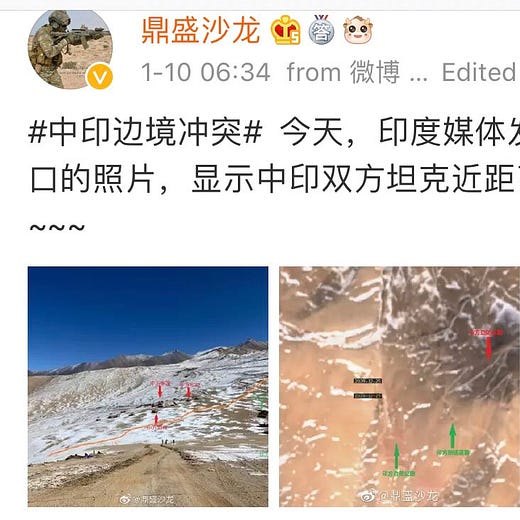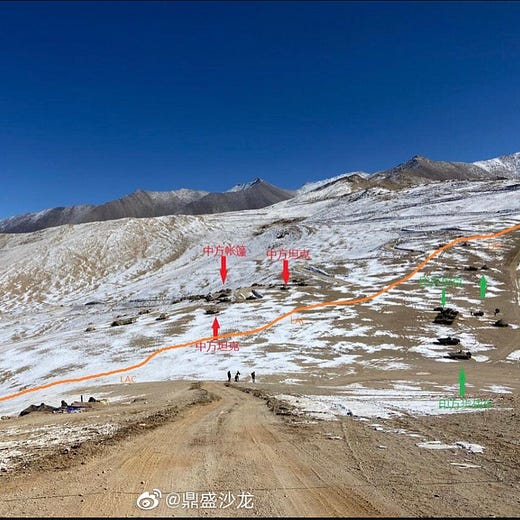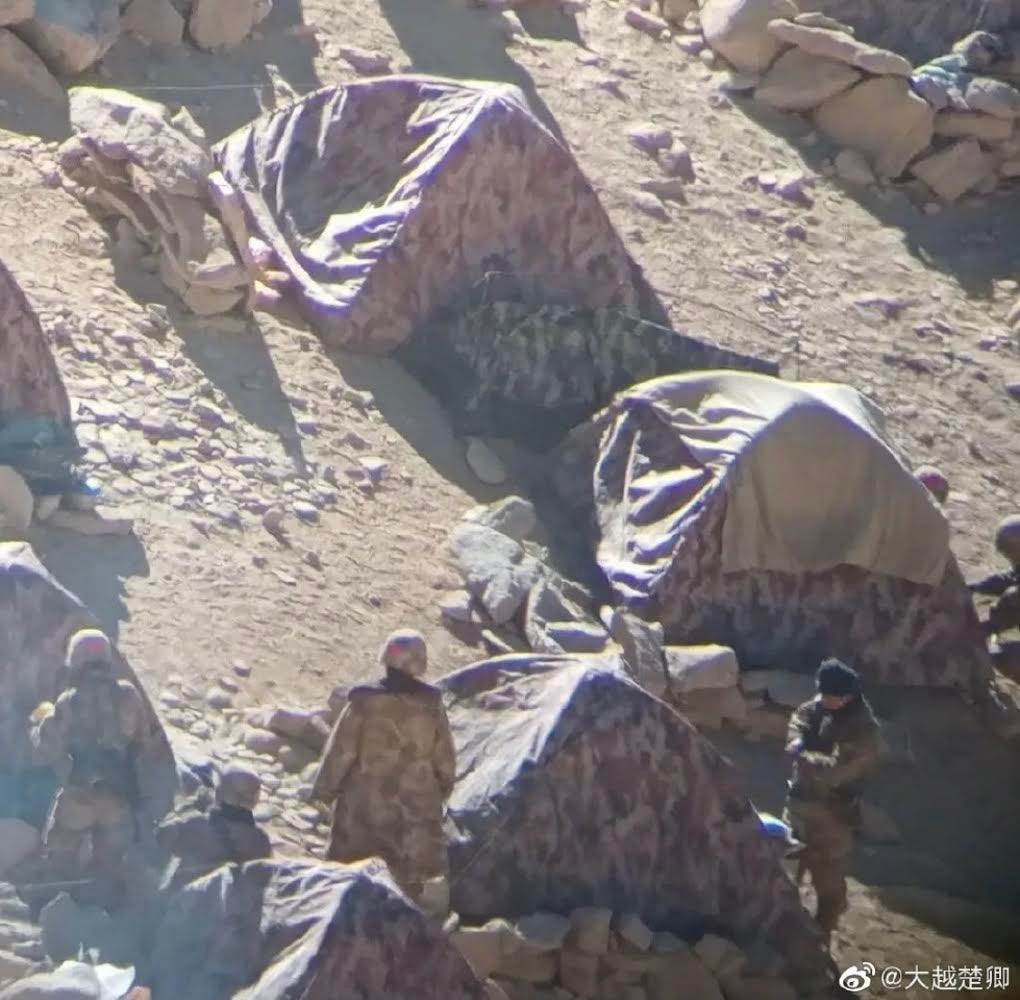Asia Communique — Week 17
Line of Actual Control: New images leaked on social media — US Indo-Pacific strategy document — US may apply CAATSA sanctions on India
Line of Actual Control: New images leaked on social media
A series of images were leaked on Weibo over the past week.
Earlier Zee News had claimed that they had obtained images that show Chinese and India tanks facing each other. Those images weren’t recent since there was no snow cover insight. But the images leaked on Weibo appear to be more recent, and they seem to have been clicked from the Indian side. The account that shared the images claimed that the pictures had been shared by Indian media. I haven’t been able to trace the images back to any Indian media outlet.
In a CCTV7 broadcast, panellists discussed the Indian Army’s plans to realign the 2 strike corps focused on Pakistan towards China. The commentators call this is move a significant shift in India’s military posture against its “neighbours”.
“Defence sources said two existing strike corps — I Corps and 17 Corps — will be slightly restructured to focus on the northern and eastern theatres respectively, to tackle any threat from China. The restructuring is likely to be implemented by this month” reported The Print had reported earlier.
“From the perspective of strategic objectives, India hopes that through the reform of the theater system, it can play an important role in the coordination of various services, multiply its military efficiency and power while expanding its jurisdiction, have more agile reaction speed during wartime, efficiently mobilize and commanded, and save a lot of resources. Under the guidance of this strategic goal, India will continue to seamlessly integrate forces at all levels of the three services in the future and propose new joint theories and strategies accordingly to help it improve its joint combat capabilities and enhance its position and influence in the Indian Ocean region” said a commentary by Fang Xiaozhi in PLA Daily.
“The Yuanwang 7 ship went to the Indian Ocean on the 15th and officially opened the prelude to the new annual maritime measurement and control mission” reported PLA Daily.
“The Indian Army on Monday handed back to China a soldier of the Chinese People's Liberation Army (PLA), three days after apprehending him at the southern bank of Pangong Tso in eastern Ladakh, official sources said” reported The Economic Times.
“A Chinese soldier who was returned to his own side on Monday by India was suffering from “acute altitude sickness”, according to Beijing-based military analyst Zhou Chenming” reported South China Morning Post.
PLA Daily confirmed the returning of the soldier.
Another set of images from the India-China border were shared on January 16. The account that posted the images claims that these images were taken by the Indian side.
“Commissioned with plateau transportation troops, the vehicle can effectively solve the problem of difficulties in delivering goods to troops stationed in plateau regions, China Central Television (CCTV) reported on Saturday” reported Global Times.
US Indo-Pacific strategy document declassified
“A newly declassified US national security document, which 7.30 has gained exclusive early access to, reveals previously secret details of the Trump administration's strategy for the Indo-Pacific region” reported ABC News.
Following the declassification, media commentaries were published in international media and the Indian media. Read the full document here.
“Some U.S. politicians want to leave behind a "legacy" by declassifying the document, but its content only serves to expose the malign intention of the United States to use its Indo-Pacific strategy to suppress and contain China and undermine regional peace and stability. In essence, this is a strategy of hegemony. I can point out at least three major mistakes in it” said Zhao Lijian on January 13.
“As countries in the Asia-Pacific, China and the United States share broad common interests in the region and common responsibility to contribute to regional stability and prosperity. We hope the United States will return to reason, reject the outdated mindsets, view China's development in an objective manner, earnestly respect regional countries' interests and aspirations, and play a constructive role in the peaceful development of the region” said Zhao Lijian on January 15.
Zhao Lijian didn’t mention India in his statement in response to the story which is a key country in the strategy document. Such an omission has been noticed in the past. India has been missing from the statements by the Chinese Foreign Minister Wang Yi in the context of US Indo-Pacific strategy or the broader role of the US in Asia.
“The differences, though, matter too. Unlike prewar Europe, the Indo-Pacific is not emerging from revolutionary upheaval and ruinous great-power war. Instead, the region has enjoyed its own 40-year “long peace.” Asia as a whole is also far more economically, financially, and technologically interdependent than Europe in the nineteenth century. The majority of Indo-Pacific trade, for instance, is conducted internally, and the region itself is central to American prosperity and growth. The challenge for U.S. policy is not to create order out of chaos, as it was for nineteenth-century European leaders, but to modernize and strengthen elements of an existing system” write Kurt Campbell and Rush Doshi in Foreign Affairs.
Commentator at PLA: Promote scientific and precise management of the officer team — PLA Daily
Wang Yi in Southeast Asia
“On January 12, 2021 local time, State Councilor and Foreign Minister Wang Yi met with Indonesia's Coordinator for Cooperation with China and Coordinating Minister Luhut Binsar Pandjaitan in North Sumatra at the latter's invitation”
“China’s Foreign Minister Wang Yi wrapped up his latest trip to Southeast Asia on Saturday, during which he sought to stabilise relations in the region ahead of the inauguration of Joe Biden as US president. But of the 10 member states of the Association of Southeast Asian Nations (Asean), Wang has visited in recent months, one was conspicuously missing: Vietnam” reported South China Morning Post.
During the trip Wang Yi stopped in Indonesia, Philippines, Myanmar, and Brunei.
Visit to Southeast Asian countries boosts solidarity against pandemic, development cooperation: Wang Yi — China.org
US might apply CAATSA on India’s S-400 purchase
“The United States has told India it is unlikely to get a waiver on its planned acquisition of Russian S-400 air defence systems, raising the risk of sanctions similar to those imposed on Turkey for buying that equipment, people aware of the matter said.
There are no signs that the US has finalized the sanctions. Earlier, a US Congressional report had said out that CAATSA sanctions might be applied to India for the S-400 purchase.
There were no long commentaries in Chinese state media on CAATSA sanctions that were noticed at the time of writing the newsletter.
Xinhua reported the story based on reporting by Reuters and the Indian media.
Buying Russian-made S-400 India may not escape US sanctions — Xinhua.
Don’t Miss Out
“The Trump administration notified Huawei suppliers, including chipmaker Intel, that it is revoking certain licenses to sell to the Chinese company and intends to reject dozens of other applications to supply the telecommunications firm, people familiar with the matter told Reuters” reported Reuters.
“China’s GDP grew 2.3% in 2020 as the world’s second-largest economy was hit hard by fallout from the Covid-19 pandemic in the first quarter but has been recovering steadily since then,official data (link in Chinese) showed Monday” according to Caixin.
“A commentary published on Sunday by PLA Daily, the mouthpiece of China’s military, said the new regulations were aimed at maintaining officers’ “basic living benefits” and establishing a better management system for career development” reported South China Morning Post. I wasn’t able to verify the “new regulation” that the journalist at South China Morning Post has referred to.
Movers and Shakers
How America Can Shore Up Asian Order — Kurt Campbell and Rush Doshi
Off Track Reads
China’s Debt Grip on Africa — Project Syndicate
Business Street
India witnessed 25 big-ticket transactions that attracted over $100-million in 2020 — Deal Street Asia
Tesla Motors will route its India investment through Dutch arm — The Economic Times
PodWorld
84. A Harsh Winter in Ladakh (with Sushant Singh) — Bangalore International Centre
Upcoming Watch
The UN Treaty on the Prohibition of Nuclear Weapons will come into force on 22 January. India, China, Pakistan, North Korea, Britain, France, Russia, and the US haven’t signed the treaty.







